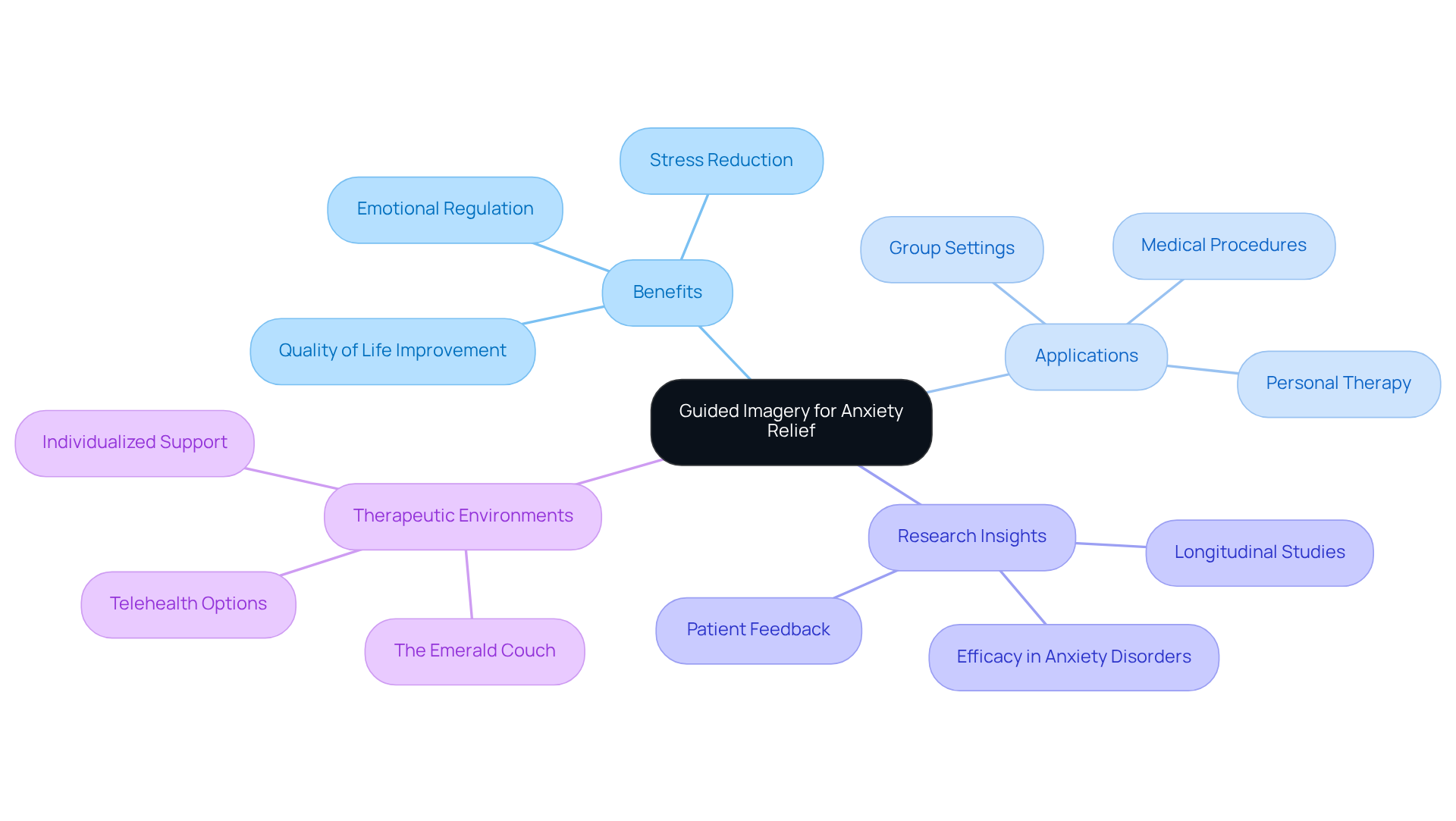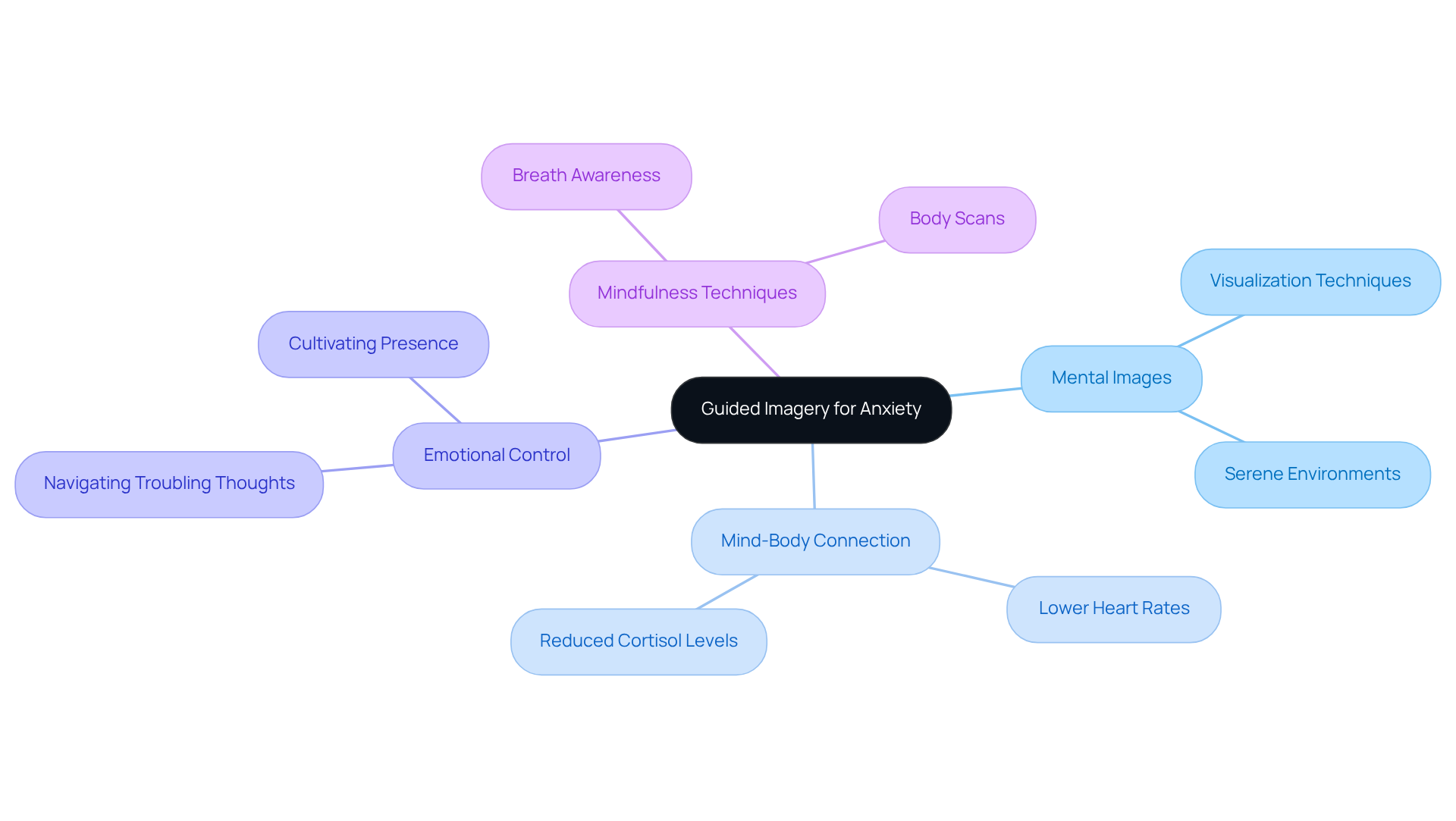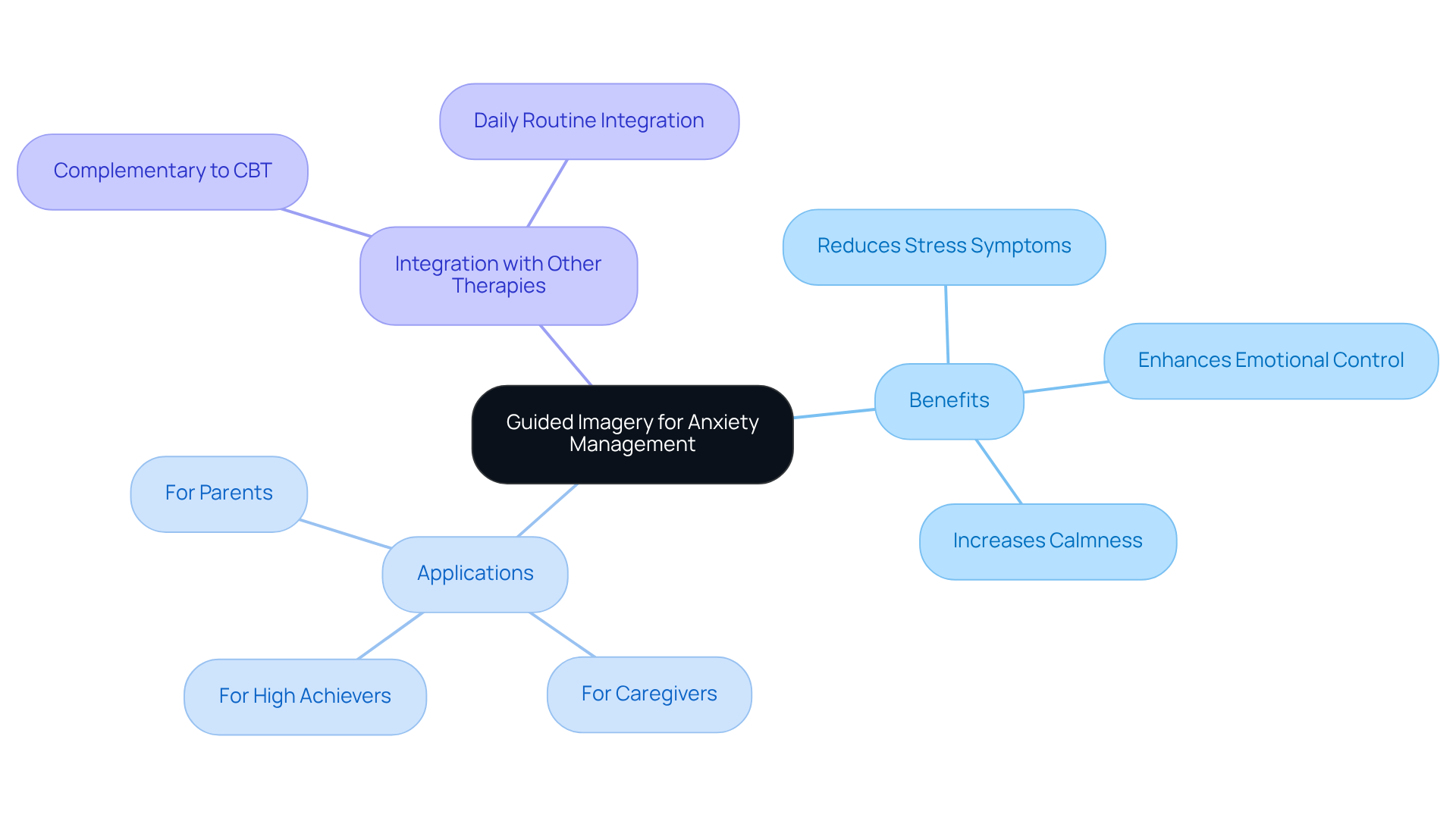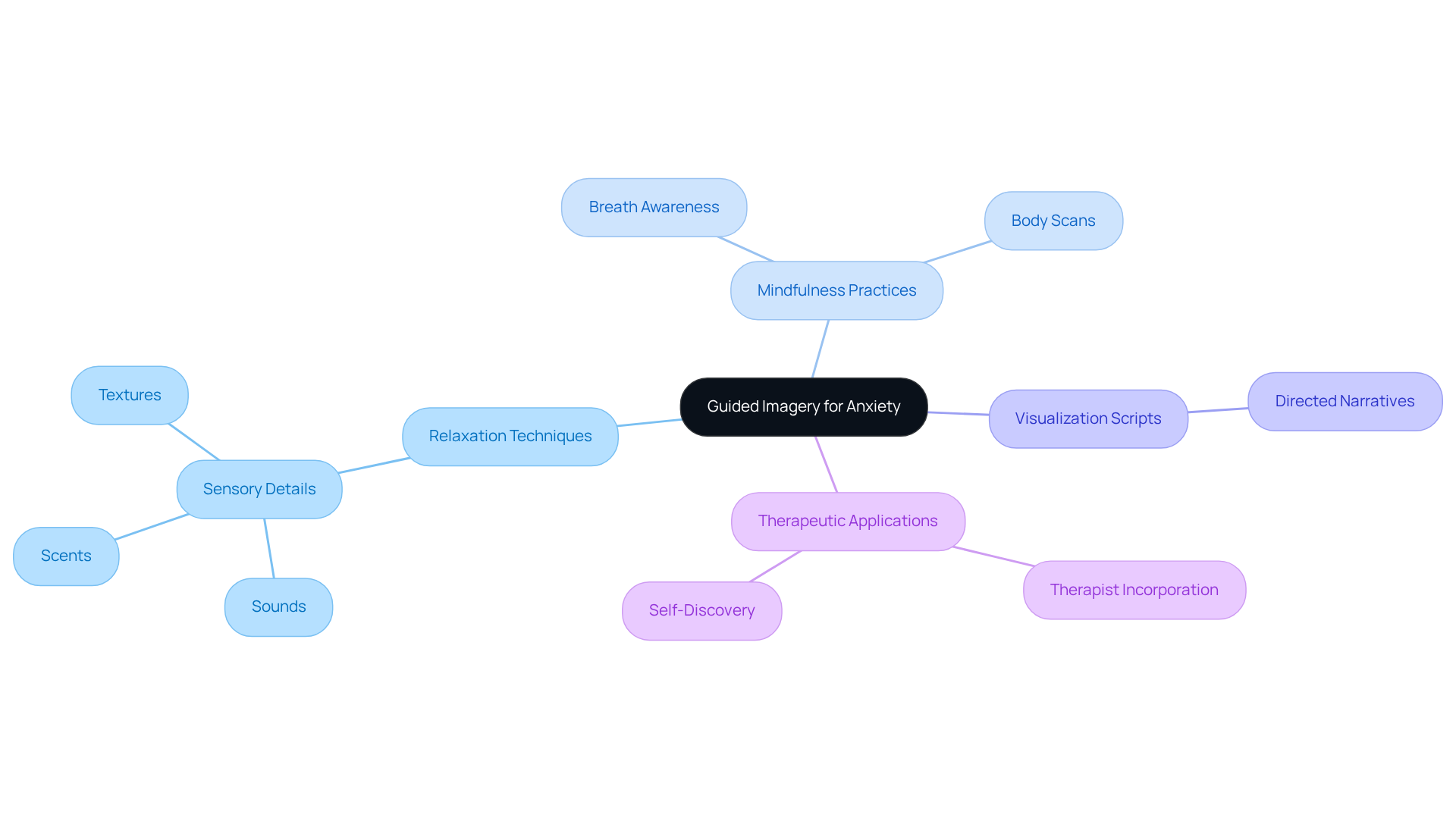Overview
Guided imagery is a gentle relaxation technique that can help manage anxiety. By allowing individuals to visualize calming and positive images, it promotes emotional regulation and reduces stress symptoms. Have you ever felt overwhelmed by your thoughts? This technique offers a pathway to tranquility, inviting you to embrace peaceful imagery in your mind.
Research highlights its effectiveness, showing improved anxiety severity and overall well-being, especially when combined with traditional therapies. This illustrates how adaptable and accessible guided imagery is as a low-risk resource for mental health support. As we explore this further, consider how this practice might fit into your own journey toward healing.
Imagine the comfort of having a tool that you can turn to whenever you feel the weight of anxiety pressing down. Guided imagery not only supports emotional balance but also encourages a sense of safety and warmth in your healing process. It’s a nurturing approach that invites you to take a step toward a more peaceful state of mind.
Introduction
Guided imagery has emerged as a transformative tool in the realm of anxiety management, tapping into the mind's ability to create calming visuals that promote relaxation. This technique not only aids individuals in navigating their emotional landscapes but also enhances their overall well-being by fostering a profound mind-body connection.
Have you ever felt overwhelmed by anxiety? The question remains: how can one effectively harness the power of guided imagery to alleviate anxiety and improve emotional resilience?
Exploring this method reveals its potential to shift perceptions of stress and provide a pathway to inner peace. As we delve deeper, we can uncover how this nurturing practice can support your journey toward emotional healing.
Defining Guided Imagery: An Overview for Anxiety Relief
Guided imagery for anxiety is a powerful relaxation method that employs mental techniques to evoke calming and positive images within the mind. Have you ever felt overwhelmed by stress or emotional challenges? This method is often utilized in therapeutic environments at The Emerald Couch, assisting individuals in managing their emotions and finding peace. By focusing on serene and tranquil situations, directed visualization allows people to tap into their creativity, promoting relaxation and alleviating stress symptoms. This technique aligns closely with mindfulness practices, such as meditation and mindful breathing, emphasizing the essential mind-body connection in achieving emotional well-being.
Research suggests that directed visualization can significantly lessen stress levels. Studies show that individuals who engage in this practice often report enhanced emotional regulation and an improved quality of life. Therapists at The Emerald Couch frequently incorporate visualization techniques into their treatment strategies, recognizing its efficacy as a complementary approach alongside conventional therapies. For instance, a longitudinal study involving patients diagnosed with anxiety disorder revealed that those undergoing visualization therapy in conjunction with standard pharmacotherapy experienced notable improvements in anxiety severity and overall well-being.
The adaptability of directed visualization allows it to be tailored to personal needs, making it a valuable resource for therapists. It can be applied in various contexts, including personal therapy sessions, group settings, and even during medical procedures to enhance patient comfort. As a low-cost and low-risk approach, guided visualization is accessible to many, offering a safe avenue for individuals to explore their mental health and build resilience against anxiety. Clients at The Emerald Couch can choose between face-to-face counseling and telehealth therapy options, highlighting the flexibility and accessibility of their mental health care. As we consider these options, remember that seeking help is a courageous step towards healing.

How Guided Imagery Works: Mechanisms of Anxiety Reduction
Guided imagery for anxiety harnesses the brain's remarkable ability to visualize and create mental images, which triggers a soothing relaxation response in the body. Have you ever imagined yourself on a serene beach or in a quiet forest? When we use guided imagery for anxiety, our bodies respond positively, leading to decreased heart rates and lower levels of stress hormones like cortisol. This beautiful mind-body connection plays a vital role in alleviating worry, especially through the use of guided imagery for anxiety, as it helps us gently shift our focus from stressors to a state of tranquility.
Moreover, guided imagery for anxiety fosters emotional control, teaching us to navigate troubling thoughts and feelings with grace. By integrating mindfulness techniques—such as breath awareness and body scans—we can deepen this enriching practice. As we nurture a non-judgmental awareness of our thoughts and feelings during directed visualization, we cultivate a greater sense of control and presence. This ultimately enhances our ability to manage stress and trauma, guiding us toward healing and well-being.
As we explore this further, consider how these practices can transform your emotional landscape. Remember, you are not alone on this journey; seeking support can be a powerful step toward finding peace and balance in your life.

Benefits of Guided Imagery for Anxiety Management
The advantages of guided imagery for anxiety in stress management are numerous, particularly for high achievers and caregivers navigating the challenges of trauma and stress. Have you ever felt overwhelmed by your past? Studies reveal that this compassionate method can significantly reduce stress symptoms, enhance emotional control, and promote overall well-being. Individuals who practice guided imagery for anxiety often express feelings of calm, reduced tension, and a greater ability to handle anxiety-inducing situations. This support is especially vital for parents facing postpartum difficulties, as they may experience heightened stress and burnout.
Moreover, guided imagery for anxiety can be seamlessly integrated into daily routines, making it a practical and accessible resource for those seeking relief from stress. This approach not only stands alone but can also complement other therapeutic methods, such as cognitive-behavioral therapy (CBT), providing clients with additional coping strategies tailored to their unique experiences at The Emerald Couch. As we explore this further, consider how these techniques might fit into your own journey toward healing and balance.

Techniques and Applications: Implementing Guided Imagery for Anxiety
Utilizing guided imagery for anxiety can be a powerful and nurturing practice that is enhanced through mindfulness techniques. Imagine finding a quiet, comfortable space where you can close your eyes and take deep, calming breaths. This simple act fosters relaxation and opens the door to a serene visualization. As you envision a peaceful scene, take a moment to immerse yourself in the sensory details—what sounds do you hear? What scents fill the air? What textures can you feel? This rich experience can be deeply soothing.
In addition to visualization, mindfulness techniques like breath awareness and body scans can further deepen your connection with your inner self. These practices allow you to explore your feelings without judgment, creating a safe space for self-discovery. If you’re new to this approach, you might find directed visualization scripts particularly helpful. These structured narratives guide you through the process, making it easier to engage with your imagination.
Therapists often incorporate visualizations into their sessions, fostering a secure and nurturing environment for clients to explore their emotions. Have you ever felt overwhelmed by your past? Regular practice of these techniques, combined with mindfulness, can lead to significant improvements in managing anxiety. Guided imagery for anxiety serves as a valuable resource for those seeking relief, inviting you to embark on a journey towards healing and understanding. As you consider these practices, remember that seeking therapy can be a compassionate step towards finding peace within yourself.

Conclusion
Guided imagery for anxiety is a compassionate mental health strategy that empowers individuals to cultivate tranquility and emotional balance through visualization techniques. This transformative method not only promotes relaxation but also enhances emotional regulation, providing a pathway for managing anxiety and stress more effectively.
The article highlights the diverse benefits of guided imagery, emphasizing its role in alleviating stress symptoms, fostering emotional control, and improving overall well-being. By integrating mindfulness practices and tailored visualization techniques, individuals can create a safe mental space that nurtures healing and resilience. Furthermore, the adaptability of guided imagery makes it a versatile tool for various therapeutic contexts, whether in individual sessions or group settings.
Ultimately, the importance of guided imagery in anxiety management is profound. It invites individuals to explore their inner landscapes, facilitating a deeper understanding of their emotions while promoting a sense of calm. Have you ever felt overwhelmed by your past? Embracing guided imagery as a complementary approach to traditional therapies can empower you on your journey toward emotional wellness and resilience. Taking that first step to incorporate these techniques into your daily life can lead to transformative changes in managing anxiety, fostering a more peaceful and balanced existence.
Frequently Asked Questions
What is guided imagery for anxiety?
Guided imagery for anxiety is a relaxation method that uses mental techniques to evoke calming and positive images, helping individuals manage their emotions and find peace.
How does guided imagery work?
This method involves focusing on serene and tranquil situations through directed visualization, which promotes relaxation and alleviates stress symptoms by tapping into creativity.
What is the relationship between guided imagery and mindfulness?
Guided imagery aligns closely with mindfulness practices such as meditation and mindful breathing, emphasizing the mind-body connection essential for achieving emotional well-being.
What does research say about the effectiveness of guided imagery?
Research indicates that guided imagery can significantly reduce stress levels, enhance emotional regulation, and improve quality of life for individuals who practice it.
How is guided imagery used in therapeutic settings?
Therapists at The Emerald Couch incorporate visualization techniques into treatment strategies, often using them alongside conventional therapies to enhance patient outcomes.
Can guided imagery be used in conjunction with other treatments?
Yes, studies show that patients with anxiety disorders who undergo visualization therapy alongside standard pharmacotherapy experience notable improvements in anxiety severity and overall well-being.
In what contexts can guided imagery be applied?
Guided imagery can be tailored for use in personal therapy sessions, group settings, and even during medical procedures to enhance patient comfort.
What are the benefits of guided imagery as a therapeutic approach?
Guided imagery is a low-cost and low-risk method, making it accessible to many individuals seeking to explore their mental health and build resilience against anxiety.
What options are available for clients seeking guided imagery therapy at The Emerald Couch?
Clients can choose between face-to-face counseling and telehealth therapy options, providing flexibility and accessibility in their mental health care.




